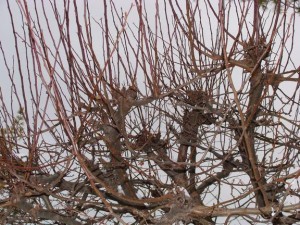Guerrilla Gardening
- Share
- Tweet
- Pin
- Share
“Science is a wonderful thing if one does not have to earn one’s living at it.” – Albert Einstein
The world of physics is ruled by rules. Remarkably a pair of laws that ya’ll memorized in middle school can be applied to gardening as well. (And, you thought you’d never find a use for such rote learning!) In fact, the winter season is probably the best time to engage in the empirical method and use observation to reprove those basic principles.
“An object in motion, tends to stay in motion,” said Isaac Newton in his First Law. While he argued in his Third Law, “For every action, there is an equal but opposite reaction.” Now, this long-dead bloke was discussing something decidedly different than your Purple-Leafed Nine Bark, but let’s run with it! Besides, gardening is all about co-opting someone else’s ideas and putting your own personal twist on ‘em. Take the bottle tree, for instance! But, we’ve digressed…
After breaking dormancy, trees and shrubs will push new growth which will continue until reaching a limiting factor (light, water, nutrient or genetics) – once in motion the plant will stay in motion. When a Felco pruner “action” is introduced into this little equation, an “equal but opposite reaction” will occur. Huh?!?
Stated another way – a woody plant is going to grow regardless of how hard you try to cut it back. And, if your pruning isn’t carefully managed, the resulting redirected growth will look stupid. Use the rules and examples below to memorize The New Laws of Physics as Applied to Gardening.
• Rule #1 – Limit your exposure to physics in the first place by planting according to mature sizes.
Example B): Plant shrubs that can be pruned to the ground each spring and thereby limit the amount of pruning required.
Example C): Use perennials in tight spaces.
• Rule #2 – Only correctly applied actions result in the appropriate reactions.
• Rule #3A –When in doubt, shout!
• Rule #3B – Prepare to hoe the long row!


